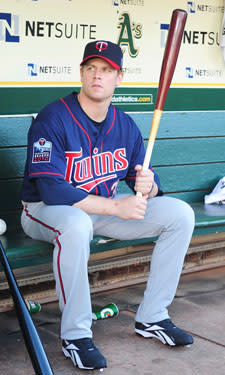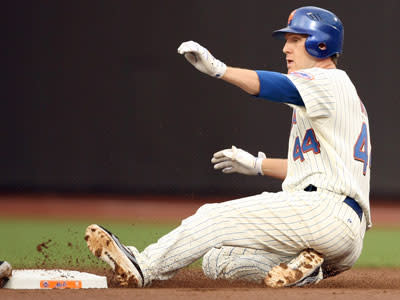Pull players immediately after head injuries
To put in better perspective what Lorenzo Cain(notes) did in making the best catch of the season, strip away all of the baseball variables. No bat. No ball. No uniform. Minus those, Cain was simply a man who ran at full speed for about 150 feet and jumped face-first into a television.
This is not meant to impugn him. Cain is fearless, a badge of honor in the athlete's ethos. His tracking a fly ball to a chain-link fence, catapulting himself into it and the TV display behind it, banging his head with incredible force and shaking it off to stay in the game illustrates that baseball is a game with serious potential for brain trauma – and one that deserves a stronger policy to protect its athletes.
Cain's removal from the game should have been mandatory, as should that of any player whose head collides with an outfield fence or who is struck in the head with a pitch. While a quick battery of on-field tests determined him fit to play, new research suggests the risks of long-term brain damage from even the slightest trauma are significantly more acute for those who stay in games after concussive incidents. Even though baseball doesn't produce near the number of concussions of football or hockey, its becoming proactive in implementing a sport-wide protocol is imperative.
Because for all the promising work from teams – the Minnesota Twins allowing MVP candidate Justin Morneau(notes) ample recovery time for a knee to the head that at first seemed relatively benign – enough mishandlings occur to necessitate a hard-and-fast rule. The fashion in which the New York Mets bungled Jason Bay's(notes) concussion by allowing him to stay in the game, then playing him for two more, shows that even MLB's best intentions can fall woefully short upon improper implementation at the team level.
"I've seen a number of instances in which it's been mishandled, and that's not unique to baseball," said Dr. Robert Cantu, a sports concussion expert and director of the Neurological Sports Injury Center in Boston. "Fairly high-profile baseball players at the big league level have been allowed back to play while still symptomatic from a previous concussion. That's an absolute no-no, and it reflected not anybody trying to do anything wrong but people who didn't have the knowledge."
MLB meets every offseason to discuss its concussion protocol, and the likelihood of it adopting a drastic change to its policy is minimal, which is unfortunate. Already it consults with a neurosurgeon, Alex Valadka of Houston, conducts baseline testing during spring training and recently gave umpires information to teach them about concussion symptoms and preventative policies. This is good. Just not good enough.
A recent study from doctors in Boston concluded that repeated brain trauma can cause a disease whose symptoms mimic amyotrophic lateral sclerosis, commonly known as Lou Gehrig's Disease. The upshot that Lou Gehrig, who frequently suffered head trauma, may not have had Lou Gehrig's Disease was the study's quick takeaway. More lasting is the ability to prevent athletes from damning themselves to a life of misery.
By automatically removing a player with an obvious head trauma, it takes the decision out of the hands of those with the most vested interest in the game: the players and trainers. Players will try to plow through pain, so their opinions are moot. And while trainers look out for a player's best interest, they also make subjective diagnoses, and a sport-wide rule on brain trauma would keep them from taking responsibility for any conflicts with a player.
When Cain smashed into the fence in Cincinnati on Aug. 30, the Brewers' training staff emerged from the dugout and ran a battery of tests on him. They examined him again during the inning break, determined he had no symptoms and let him play. He missed the next day with a stiff neck, then came back for the following game.
"The time to return to play," Roger Caplinger, the Brewers' head trainer, said in an email, "is a collaboration between the physician, player and athletic trainer."
The Brewers learned from third baseman Corey Koskie's concussion four years ago. He returned too quickly, which exacerbated his symptoms, and what looked like a harmless play ended his career at 33. When Carlos Gomez(notes) was beaned a month ago, he left the game and waited for his warning signs to subside. They didn't. He landed on the disabled list, opening the center field job for Cain.
The Mets didn't learn from Ryan Church's(notes) long-lasting concussion two years ago. Bay's catch looked similar to Cain's, with his body flying into a fence, and it rattled his head significantly. Bay became the eighth major leaguer this year to go on the disabled list with a concussion. In 2009, there were six.
"Because the likelihood of concussion is fairly low, the majority of the team doctors in baseball, and the trainers for that matter, don't deal with concussion but maybe once or twice a year," Cantu said. "You're best at what you're doing all the time, and as a result, the care that's given to players on average is way under what it is in certain other sports, where what they see and have to deal with all the time are concussions."
Cantu, a neurosurgeon for more than 40 years, played baseball at Cal. He acknowledges the damage from taking a 90-mph fastball to a helmet woeful at protecting brain trauma, or a player launching himself at a stationary object, is every bit as dangerous as football. The NFL last season updated its concussion policy to say a player "should not return to play or practice on the same day if he shows any signs or symptoms of a concussion."
He suggests specialized concussion training beyond the symposiums MLB has held for trainers and doctors at the Winter Meetings, and those certainly would help if MLB chose to allow players to stay in the game. "I'd rather," Cantu said, "see the level of sophistication of the people making these decisions get educated and upgraded."
MLB can do one better. The removal of players would send a tremendous message: Even in a sport where concussions are rare, they're nothing with which people should trifle. Only now, after decades of research, are specialists beginning to understand the brain's response to head trauma. How, then, can we expect physicians and athletic trainers to specialize in it enough to treat something of such import effectively?
Call this what you may: an overreaction, a penalty for hustle, another sign of wussification. Just make sure to also call it what it is: the right thing for everyone. Baseball is not about valor, not about toughness, not about any intangible whose measure is in machismo instead of logic. Brain trauma imperils people. This rule would limit the potential destructiveness of brain trauma. It is about the lives, and livelihoods, of players. A game here, a few there – it's grand-scheme peanuts.
So go ahead, Lorenzo Cain. Run those 150 feet and barrel into the TV and land on every highlight show across the country. Just come out of the game after doing it. For your own sake and the sport's.


